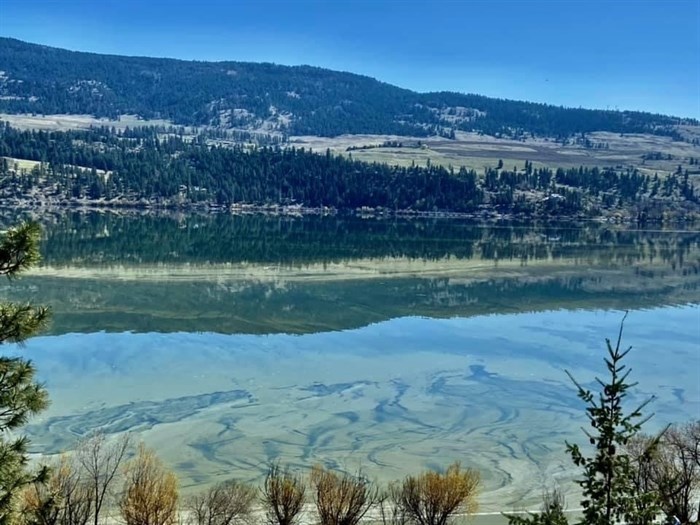
This algae bloom showed up in Wood Lake last spring. A similar bloom could grow in the north arm of Okanagan Lake this summer.
Image Credit: SUBMITTED/Geri Allan-Helmer
January 25, 2022 - 6:30 AM
One of the more visible and immediate legacies of the White Rock Lake wildfire for many on the west side of Okanagan Lake could easily be a slimy looking algae bloom next summer.
That will depend on how big a runoff comes in the spring from the area damaged by the fire, which stretches from just north of Fintry up the entire length of the Armstrong Arm past Vernon.
“That fire just absolutely pummelled a number of entire watersheds up there,” Jamie Self, aquatic biologist with Larratt Aquatic Consulting, told iNFOnews.ca. “Fires of that intensity will fundamentally change the way that water behaves. It makes soil hydrophobic, so rain and snowmelt just run off it. The soil has no vegetation to hold it back so there will be more slope failures and sediment inflows. All these things equate to more nutrients in the lake.”
Larratt Aquatic has a particular interest in algae blooms. Self suspects that floods in 2017, 2018 and 2020 were likely responsible for a major algae bloom in Wood Lake last year.
READ MORE: Interior Health warns of potentially harmful algae bloom on Wood Lake
Floods bring nutrients off the forest floor into lakes.
“You get a large pulse so, for the next couple of years, you’ll see elevated nutrient productivity,” Self said. “We assume that’s part of what’s going on in Wood Lake where we had a pulse of nutrients from a couple of flood years.”
He’s just not sure if that’s the full cause of the Wood Lake algae bloom or if there are other reasons.
“That’s kind of the question – have we pushed across a threshold or is it just going to take a couple of years to settle down?” he said. “It’s kind of difficult to tease out between the two just because we’ve had so many strange years in a row. Just give us a couple of normal years so we can figure it out.”
Normally it takes a year or two after a major inflow of nutrients for the algae to bloom but Self won’t be surprised if it shows up this summer in the north basin of Okanagan Lake.
A study by his firm that was released last spring looked at water clarity in various parts of Okanagan Lake for the previous decade and found the poorest quality in the shallow north or Armstrong Arm, making it more likely to foster algae blooms.
READ MORE: Okanagan Lake's north end most impacted by human activities: study
That, combined with the magnitude of the watersheds damaged by the wildfire puts the arm at risk.
“It will enter into the lake as a plume and spread out,” Self explained. “Some of the nutrients will sink to the bottom and some of it will just spread out. The bacteria in the sediment, for their own reasons, will mobilize the nutrients so they will turn it from an insoluble to a soluble form that goes back in the water column where it can be used by the algae.”
More food for the algae means more growth.
Algal blooms are naturally occurring throughout B.C. and may vary in colour from blue, green, brown, yellow, orange to red and appear like foam, scum, mats on the surface or soup. Some algal blooms may also smell unpleasant and some produce harmful toxins.
Algae blooms also form more easily in shallower water.
“The depth affects the way nutrients move through the ecosystem because it’s the bacteria in the sediments that will recycle nutrients,” Self said. “The closer the sediment is to where the sunlight is, the faster that recycling can happen. That’s why you see such a difference between Wood Lake and Kalamalka Lake, even though they’re connected, because Wood Lake is much shallower.”
Self wouldn’t expect to see algae blooms near Summerland or Kelowna.
“I wouldn’t be surprised to see algae bloom in the north basin in 2022,” he said. “I would be happy to be proven wrong on that.”
To contact a reporter for this story, email Rob Munro or call 250-808-0143 or email the editor. You can also submit photos, videos or news tips to the newsroom and be entered to win a monthly prize draw.
We welcome your comments and opinions on our stories but play nice. We won't censor or delete comments unless they contain off-topic statements or links, unnecessary vulgarity, false facts, spam or obviously fake profiles. If you have any concerns about what you see in comments, email the editor in the link above.
News from © iNFOnews, 2022